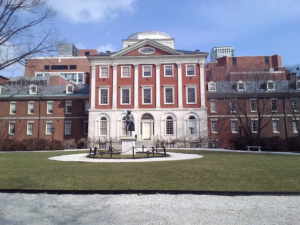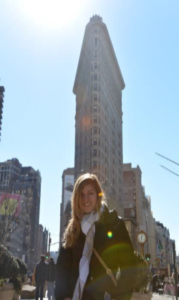Student Report by Nicola Hermann
 This Program gives you the valuable opportunity to study at one of the Ivy-League Universities, which is ranked at the very top of all medical schools. You become a part of the medical educational system of the United States for 3 months. It shows you the effectively structured American approach to teaching and ended up being a great learning experience in my life as a medical student.
This Program gives you the valuable opportunity to study at one of the Ivy-League Universities, which is ranked at the very top of all medical schools. You become a part of the medical educational system of the United States for 3 months. It shows you the effectively structured American approach to teaching and ended up being a great learning experience in my life as a medical student.
You can download this Report as a PDF here.
As an Austrian med student at Pennsylvania Hospital
When I arrived in Philadelphia I had a mixed feeling of excitement, happiness and uncertainty, because I wasn’t sure what I was expecting. I was worried that I learned different things in Europe and that I wouldn’t be able to keep up with the requirements and tasks the Americans had for students. It turned out that these concerns were not proven true.
Since this program is designed for international students coming over to the USA for the first time, you are being taught what to do from the very beginning. As long as you bring your short white coat (you should buy that i.e. at Jefferson Book Store once you’re there), your stethoscope, some device you can take notes with and an American phone (communication is everything) – you’re very well equipped for the first day.
I had the chance to see outpatients in the outpatient clinics which are located across the street from the hospital as well as inpatients in the hospital. Depending on the rotation and the amount of consults the service had I spent more time in the one or the other place.
Conferences: The PAH offers a great number of very good conferences (e.g. noon conference, thoracic conference, gamma knife conference). We got schedules and picked out the topics we found the most interesting.
Consults: Doing consults is the main activity as a student in this program. They are exclusively performed on inpatients and are a great opportunity to learn. For example when you’re on your Pulmonary rotation and a patient on a General Medicine service in the hospital is suspected to have a special pulmonary problem, you go to the floor where the patient is located, gather all the information you consider important in this matter (from the computer system and chart, and maybe – if you have the chance, by talking to the covering provider or the covering nurse) and ultimately see the patient, talk to him or her and do a physical exam. Now – loaded with information – you structure it on your written consultation report to get ready to present the patient to the attending doctor.
Find an example of a consultation report here.
The structure of the consultation report is an acronym and is called S-O-A-P. It contains the following information:
S (Subjective): The Story of the patient – chief complaint, history of present illness, past medical history, past surgical history, medication, allergies, review of systems,
O (Objective): Any objectified parameters – vitals, physical exam, test results (i.e. labs, imaging)
A (Assessment): Summary of the most relevant points from the above to envision the patient and the problem (e.g. 31-year old male patient with a medical history of HIV diagnosed in 2007 which is currently untreated (CD4 count an viral load currently unknown), who presented with progressive shortness of breath, fever and nonproductive cough starting one week ago. Clinical presentation, physical exam showing mild crackles at the lung bases, elevated LDH-levels and CT-Thorax showing generalized patchy ground glass opacities and interlobular septal thickening are highly suspicious for Pneumocyctis jiroveci pneumonia. Differential diagnoses (e.g. CMV-Pneumonia, TBC,..)
P (Plan): What do you plan for the Patient? Further Testing (e.g. CD4 count and viral load, Bronchial lavage with testing for PCP, AFB-Staining, Cultures); Treatment options (e.g. TMP-SMX 10 mg/kg/d; Start of antiretroviral HIV Therapy)
In order to come up with a good plan and to prepare for the talk with my attending I liked to use some support by two good websites:
1) http://www.uptodate.com/home
After my consultation I was able to present my patient to my attending physician and we could talk about the case before we saw him or her together. On the basis of the patient I was already familiar with, the attending could teach me very well, I could ask questions and they took a lot of time and interest in giving me a good teaching/learning experience.
Interestingly all consultations reports, admissions and signout letters were written using the SOAP-Pattern. In my experience it gives you security because you have something to hold on to and it keeps you from forgetting important things.

Rotations
Hematology/ Oncology
The Heme/Onc Rotation is always the first station a student in this program is taking. Hence, the people we worked with in this field introduced us kindly to the student life at Pennsylvania Hospital. We were able to spend time with Dr. Henry, who is one of the heads of the department of internal medicine at PAH and the American director of our Austrian-American exchange program. Our tasks were very actively designed in the inpatient field, in which we did the consults (see above) and more passively in the outpatient area. Here we accompanied one attending according to the schedule we received in the beginning. We were able to examine the patients and ask questions.
Pathologies we could characteristically observe in the Heme/Onc Rotation were cancers and pre-stages of cancers of all kinds (carcinoma, sarcoma, lymphoma, leukemia, …), blood clotting disorders, anemia, and an impressive number of sickle cell- and HIV patients.
What I consider great about this rotation are the frequent teaching rounds in the mornings with the responsible attending and teaching sessions in the path-lab, where we were able to look at smears and talk about the related illnesses. Besides great teaching from Dr. Henry, also Dr. Beach, Dr. Mintzer, Francesca Ferraro and Shakira Grant took very good care of us, doing extra sessions.
Gastroenterology (GI)
This Gastroenterology service was predominantly a consult-service. Since GI had a lot of consults there was a nurse practitioner employed to do them and then present the patient to the attending.
Consult reasons typical in this field were anorexia, anemia with positive FOB, melena, hematochezia, diarrhea (if not IBD, then especially C. diff), gastric paresis, inflammatory bowel diseases (especially in young patients), hepatitis, hepatic cirrhosis with esophageal varices.
Patients often received an upper or/and lower endoscopy following the consults, which I was able to watch. These procedures were interesting for me, since I already worked with the patients and knew their history. Extra events were an interactive conference at the University of Pennsylvania which I watched with Dr. Nunes.

Pennsylvania Hospital- the oldest hospital in the States, © N.Hermann
Infectious Diseases (ID)
Luckily I got the chance to be on the Infectious Disease service for one week. Doing ID as a student, you are on the consult team, which consists of one attending (in my case Dr. Braffman), two residents and one or two students. We usually met at 8 am in the cafeteria, distributed the consults, and presented the consult to the group when meeting again. The team then saw the patient again together and discussed the case, differential diagnoses and a plan for the patient. New incoming consults or follow-ups were distributed every time the team gathered again. Diseases I saw were tubo-ovarian abscess, cellulitis after drug injection, abscess in triceps muscle after drug injection, sepsis in context of hip-replacement surgery (see below in ICU-patients), pancreatitis in Lupus, pneumonia in HIV, chest pain plus cough with thoracic CT showing a big round cavity lesion in the lung, and many more. The reasons primary care providers consulted ID was the question of the right antibiotic/ antifungal/ antiviral coverage and question for further testing and/or differentials.
My week in ID was great, since Dr. Braffman and his team were a joy to work with. Highlights were a trip to the microbiology-lab, where we could look at pathological blood cultures, and the big ID conference I visited with the other student Mallory at the University of Pennsylvania.
Pulmonology/ Intensive Care Unit (ICU)
My last Rotation was a combination of Intensive Care Unit (Rounds in the Morning, then teaching Rounds) plus Pulmonology consults and Outpatient Office.
ICU: The Intensive Care Unit was led by one of the Pulmonologists and their team (2 residents and 3-4 interns, a pharmacist).
First the team met at 8:00 am for a round-table talk, covering the patients in the ICU and answering questions before seeing them while doing walking rounds.
After being done with patient care and the interns and residents being put in order for the patients, there was time for teaching rounds. The ICU attending talked about a certain topic (e.g. vasopressors, sedation or respirator) and we were able to ask questions (and get answers). In the afternoon I could also take part in very effective interactive teaching units residents like Lucas Kimmig gave for the ICU team, in which we would for example go through the algorithm for tachycardia.
Reasons why people were in the ICU were diverse: A remarkable number of patients was in withdrawal (usually from alcohol), many where chronically very sick patients in a critical state of one of their illnesses (e.g. 72yo female with endometrial sarcoma with involvement of the ureters and sepsis; 45yo female with end-stage renal failure, nutritive-toxic hepatic cirrhosis with sepsis after an infection of the hip-prosthesis shortly after the surgery; 80yo male myasthenia gravis already involving the breathing muscles), others were there by “accident” (e.g. 70yo female eating clams and having an anaphylactic shock; 42yo female with toxoplasmosis in untreated HIV; 35 yo female with influenza pneumonia, not flu vaccinated, and ARDS 22weeks pregnant stadium post spontaneous abortion on day 1 of her hospitalization). The ICU-Patients were very diverse and included very young very sick people.
If there was a consult I would do it after ICU rounds or after noon conference. Pulmonary consults were usually requested for sleep apnea, dyspnea plus cough if there was a sign for an origin other than cardiac (e.g. asthma, complicated pneumonia), hemoptysis, COPD exacerbation, a cryptic chest CT. Doing consults in Pulmonary with a special focus on the lungs, it was important to ask people about a history of asthma or COPD, blood clots, a positive tuberculosis test, pets/animal exposure, occupation, medication, smoking in pack years and highest/lowest amount.
Besides being in the ICU with Dr. Lugano and doing consults with Dr. Mahr I was also able to work with the sleep-specialist Dr. Kotler. We saw Sleep-apnea patients in his office together and he taught me important risks for obstructive sleep apnea, which accounts for 95% of all sleep apnea (the other 5% is central) such as obesity or a high Mallampati score, which is an indication for an anatomically narrow airway that is more likely to be obstructed than a normal airway. I also visited the sleep laboratory and witnessed the beginning of a sleep study.
Living in Philadelphia

Nicola Hermann in New York City
My fellow Austrian student and I lived in International House (IHouse), a student home for people from all over the world. Since we caught a strong winter with icy temperatures and a lot of snow, I was happy about the opportunity to join a fitness center (UPenn gym), which was located just one block from IHouse, to get some exercise. Notably, there was an Ice Rink at Penn’s Landing, where you could enjoy Ice skating with a special view over the Delaware River to Camden, New Jersey. Close to IHouse there are also UPenn Sports facilities like a tennis court we played on at a fun house staff event. Philadelphia itself has a lot to offer concerning restaurants, typical American bars, museums or curiosities like the Farmer’s market, where you can buy your food from the Amish. Trips to New York City and Boston were fantastic highlights, which were not that expensive since I/we used cheap bus offers from Megabus or Greyhound.
In summary I can recommend the Philadelphia Rotation to anyone who is interested in Internal Medicine and who is keen on getting to know an excellent medical educational system quite far away from home.
You can download this report as a PDF here.
If you are interested in working abroad as a medical student or doctor, click here for more information.
Tip: More up to date educational events dealing with healthcare can be found online on the Education Database »medicine & health«.
